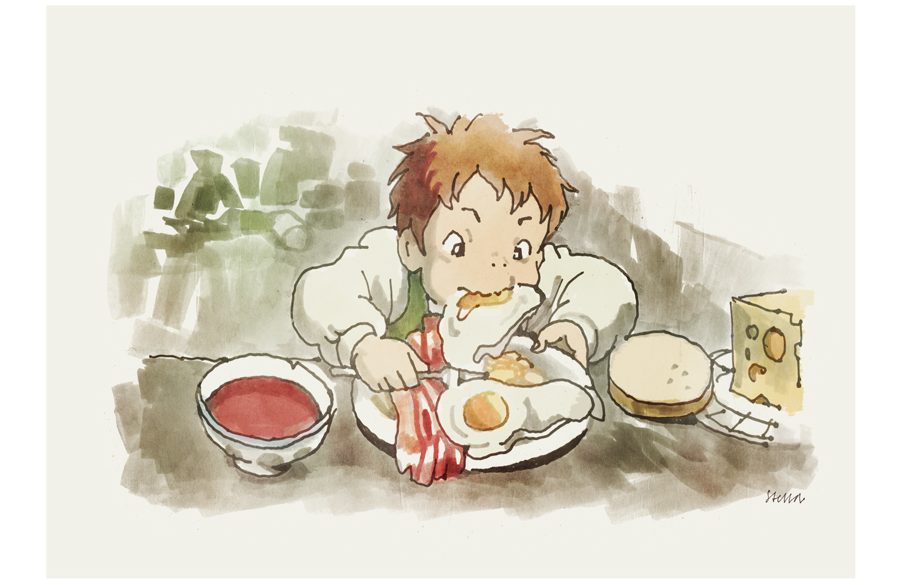The Importance of Food in Howl’s Moving Castle

Howl’s Moving Castle by Hayao Miyazaki is one of my favorites if not my very favorite movie. I’ve written about it here before at some length. I use pictures from it as my Twitter background, as my login prompts on both of my computers, and my pinned tweet is a quote about the film and its simple-yet-allegorical applicability to understanding your own life and psyche.
One aspect of HMC I haven’t touched on here, but is essential to understanding the film and its appeal, is the importance of food in the film. Luckily, Sarah Welch-Larson at Bright Wall/Dark Room has you covered.
First, there’s this remarkably concise and comprehensive survey of food in the Miyazaki-verse:
In Studio Ghibli movies, food is a feast for the eyes. Nearly every one of Hayao Miyazaki’s films includes a memorable shot of food, some more extravagant than others. A monk stirring a pot of soup on a cold night in Princess Mononoke. A herring pie, golden and steaming, fresh from the oven, in Kiki’s Delivery Service. Ramen noodles piled with toppings in Ponyo. Piles of roasted meat and dumplings spilling across the counter of an enchanted restaurant in Spirited Away. Even the Miyazaki films that don’t focus so heavily on food still allow their characters a chance to pause and eat. Nausicaä stops for a moment to eat a small bag of nuts as the world falls apart around her. Porco Rosso eats spaghetti bolognese as he hides out from the Italian authorities. Extravagant or simple, quick or languorous, the shots of food in Miyazaki films all tempt the senses.
Then this close reading of food and its themes in Howl:
In Howl’s Moving Castle, food is more than just a necessity. It sustains life, in every sense of the phrase: it helps a body hold skin and sinew together, and acts as an expression of love and care. We get the sense that Howl is a good person from the way he prepares breakfast. He has a sure hand, and a light touch. He might be flighty, but he cares enough to put together a well-cooked breakfast big enough for everyone in the room, including Sophie the interloper.
Food is also an expression of identity. Howl’s cooking is simple and elegant, but feels like a feast. The bacon is thick and crackling, and the eggs are perfect, cooked sunny-side-up with not a single yolk broken. Sophie’s own choices of food are plain and practical, like her, but that doesn’t make them any less valuable than the more extravagant examples of food we see in other Miyazaki films. Her bread and cheese look just as tasty as Howl’s bacon and eggs, and they’re likely just as satisfying. Calcifer, too, needs to eat, despite being a supernatural creature. He stuffs logs into his mouth, one by one, every time he needs to move the castle. When he isn’t active, he’s still perpetually consuming wood, albeit at a slower pace; fire is a hungry creature, and will go out if it is not fed.
Hunger in Howl is twofold: it can be the desire to be sustained, and it can be the desire to possess. This second desire takes the form of gluttony, and it is a destructive force. While he’s out in his wanderings, Howl comes across battles between the two rival countries. He refuses to fight, but he can’t stay away; the war is encroaching. Other wizards who swore loyalty to the king take part in these battles, and on more than one occasion, Howl is chased through the skies by the “hack wizards” who turned themselves into monsters in service of the war. They’re horrible half-lizard, half-dragonfly things, all oily skin and gaping mouths full of sharp teeth, open as if ready to devour. Miyazaki’s war imagery tends toward images of devouring, but the action of eating here is neither life-giving nor sustaining. War is gluttony, a force that needs to mindlessly consume until there is nothing left.
And this remarkable conclusion:
The kitchen is said to be the heart of a home, and Howl’s kitchen was empty until Sophie talked her way in to clean it. Food and love are both life-sustaining forces, but only when held lightly, without thought of possession or ownership. Sophie saves Howl without a thought for her own happiness, and, in return, Howl loves her back of his own free will. Neither takes what the other is not willing to give. Their love is neither greedy nor ravenous, but rather a hunger for food that sustains and leaves the hungry satiated.
I’m convinced: food, and the overlapping and contradictory economies of food, are the keys to this movie! This puts it up with Babette’s Feast as my favorite movies about food, love, and community. Thank you, Sarah, for helping me appreciate this remarkable film in a whole new way.
(Thanks too to @nandelabra for pointing this my way.)





Stay Connected